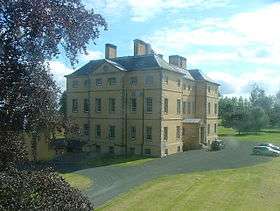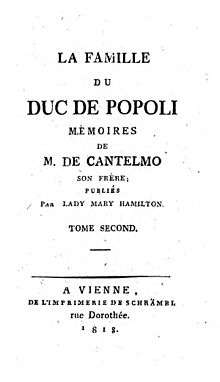Lady Mary Hamilton
Lady Mary Hamilton or Lady Mary Walker (née Leslie; 8 May 1736 – 29 February 1821) was a Scottish novelist of the 18th century. She was the youngest daughter of Alexander Leslie, 5th Earl of Leven and the mother of James Walker, a Rear admiral in the British Royal Navy.
Lady Mary Hamilton | |
|---|---|
| Born | 8 May 1736 Melville House, Fife, Scotland |
| Died | 28 February 1821 (aged 84) Brompton, Middlesex, England |
| Spouse(s) | Dr. James Walker George Robinson Hamilton |
| Father | Alexander Leslie, 5th Earl of Leven |
| Mother | Elizabeth Monypenny |
Her works included discussions of philosophy, education and art. Advanced in thinking for the time period, she was a strong advocate of education for women. Her most successful novel, Munster Village (1778), centres on a utopian garden city populated with fallen women and females escaping disastrous marriages. Jane Austen may have been influenced by her writings, taking the same names as some of Lady Mary's characters.
Family and personal life

Lady Mary Leslie was born at Melville House, Fife, Scotland on 8 May 1736, the youngest daughter of Alexander Leslie, fifth earl of Leven and Melville, by his second wife Elizabeth, daughter of David Monypenny.[1][2]
On 3 January 1762, Lady Mary was married to Dr. James Walker of Innerdovat, Fife. He was a physician based at Edinburgh's prison infirmary[3] and heavily in debt.[2] Though the marriage was unhappy, it was said to have produced ten children.[4] At least half must have died in infancy; the Scots Peerage, followed by McMillan, asserts three sons and one daughter[5][1] though other sources point to two Walker daughters, Isabella (Bell) and Elizabeth (Betzy).[5][6] (A grandson, Baron Adolphe Thiébault, raised questions about the paternity of Lady Mary's children, in an 1863 history.[4]) Lady Mary was estranged from Walker, who moved alone to Jamaica in the 1770s to take up a position there as a prison physician.[6]
Lady Mary turned to writing to provide for her family.[2] She would later note to a friend that "with a family of young children… abandoned by their father," she was forced to "cloath, feed, and educate them".[1] She thus needed to support herself, producing her first novel Letters from the Duchesse de Crui (1777).[1][7]
Lady Mary was introduced by her husband to George Robinson Hamilton[6] and – accounts vary – sometime after Walker's death,[7] (alternatively, without divorcing Walker[6]) she went away with[3] or married[8] Hamilton, a cousin of Alexander Hamilton, 10th Duke of Hamilton and owner of a sugar plantation in Jamaica.[8][4] She took Hamilton's name, and she and George settled in Lille, France in 1782,[4] where he is described as a cloth merchant and they as living in great style.[6] Two of her daughters with Walker, Isabelle and Betzy, married respectively the dramatist Victor-Joseph Étienne de Jouy and General Paul Thiébaut. Again, accounts vary: Lady Mary had two daughters with Hamilton,[1] or had at least one surviving daughter with Hamilton, Sophia Saint John Hamilton Alderson.[5]
George Hamilton died on 29 October 1797,[4][5] and an analysis of his will demonstrates both that he and Mary were not married, and that James Walker was still alive in 1786.[5] Hamilton made over all of his estate to Lady Mary, with the stipulation that the Jamaica estates were to be run for Mary's benefit by James Hope-Johnstone, 3rd Earl of Hopetoun and Alexander Leslie-Melville, 7th Earl of Leven (Mary's nephew).[5]
After Hamilton's death, Lady Mary lived near Amiens, where she was very close to the writer Sir Herbert Croft.[8] Croft was an eccentric English scholar who had compiled dictionaries, and the two lived there together as friends.[1] Her daughter Bell and son-in-law Jouy visited them often.[9] Croft introduced her to his secretary, Charles Nodier. Nodier translated Munster Village and helped her write another book in French, La famille du duc de Popoli or The Duc de Popoli (1810).
Despite her extensive holdings in Jamaica, little or no income was earned from them and the Croft household was poor.[9] In 1815, (in alternate sources, at age 75[5]) she went to Jamaica, as she believed she was being cheated financially out of some of her husband's estates, which had produced £3000 per annum but were now yielding £400.[5] After her return – Croft having died in April 1816 – she lived with her daughter Sophia Alderson, who was widowed. Lady Mary died in Brompton, Middlesex near London on 28 February 1821,[10][5] although some sources such as McMillan specify an 1822 date of death.[1] The discrepancy may arise out of a delay in proving Lady Mary's will, which took until 5 July 1822 to be settled[1] in favour of Sophia and her son Lieutenant-Colonel Leslie Walker.[1] Her son James Walker, a Royal Navy officer, achieved the rank of Rear-Admiral.
A final conjecture concerning Lady Mary and her daughter Sophia is made by Wicks, that Sophia may have had an illegitimate daughter in 1805, fathered by Ugo Foscolo, and that the child, Floriana, was adopted and raised by Lady Mary (leaving Sophia free to marry). On Mary's death, Floriana was entrusted to the care of her father, and some or all of Sophia's inheritance was directed to Foscolo to provide for Floriana.[11] That Ugo and Sophia had a daughter is supported by Traversa;[12] and analysed, doubted but not discounted by Vincent.[13] If true, then a corollary is that Lady Mary and family lived for some time in Valenciennes, before moving to Amiens.[14]
Literary analysis
Her most successful work, Munster Village (1778), centres on a utopian garden city[7] and features themes of intellectual equality, especially in marriage. Historian Dorothy McMillan writes that "the novel was one of the earlier works of the period to feature an ideal community".[1] Hamilton creates the village from scratch and it is populated by fallen women and females escaping disastrous marriages. The community survives because it is driven by the exchange of kindness.[3] Christine Rees has termed it "a drama of family relationships" which features the strong "moral sentiment" common of many 18th century writers.[15] However McMillan argues that "the writing is marred by sententiousness and relentless intellectual name-dropping".[1]
Contemporary reviews of her books were in the main very favourable. The Critical Review, edited by Tobias Smollett, met the publication of the Letters from the Duchesse de Crui with high approbation – "the solidity of her remarks might do honour to those of the opposite sex"[16] – and were equally approving of Memoirs of the Marchioness de Louvoi.[17] The Monthly Review commends the "just observations, useful reflections and pertinent allusions to natural and civil history" found in Memoirs of the Marchioness de Louvoi.[18] However its review of The Life of Mrs. Justman is scathing, speaking of the "absurd, incoherent and contradictory political reasoning with which these volumes abound" and finding its best feature to be that 75 pages of the manuscript were destroyed by fire.[19]
Lady Mary's writings included discussions of philosophy, education and art.[7] However, McMillan posits that her works "have little to offer modern readers"[1] and The Cambridge Guide to Women's Writing in English has critiqued her stories for plagiarizing from others.[7] Alessa Johns also notes the plagiarism but argues that rather than be a self-serving attribute, it reflects Lady Mary's view of a "public-spirited will to share and democratize" ideas and a sincere form of flattery.[20] Indeed, one of her characters in Letters from the Duchesse de Crui says to not call her "a plagiarist... from whatever author I may have borrowed them, I shall give their names, when I recollect them: but to trace the origin of my ideas, would be an endless task".[21]
Nevertheless, Lady Mary's views on marriage and equality show that she was advanced for her time period.[7] She was a strong advocate of women's education.[2] Hamilton's stories may have influenced Jane Austen, as the English author included several of Hamilton's names in her works: Bennet and Bingley in Pride and Prejudice, and Dashwood in Sense and Sensibility.[1] Johns observes that Hamilton's feminist utopian ideas also influenced Mary Wollstonecraft and Catharine Macaulay.[22]
A collection of her papers is held by Yale University Library.[4]
Works

She published the following works:[7]
- Letters from the Duchesse de Crui, 1777
- Memoirs of the Marchioness de Louvoi, 1777
- Munster Village, 1778
- The Life of Mrs. Justman, 1782
- The Duc de Popoli, 1810
References
- McMillan 2004.
- Rendall 2006, p. 363.
- Snodgrass 2006, p. 551.
- Ducharme 2010.
- Wicks 1937, pp. 296–300.
- Sigler 2005.
- Sage 1999, p. 302.
- Alger 1890.
- Oliver 1964, p. 60.
- Rendall 2006, p. 364.
- Wicks 1937, pp. 41–43, 296–300.
- Traversa 2005, p. 6.
- Vincent 1953, p. 210-211.
- Wicks 1937, pp. 41–43.
- Rees 1996, p. 227.
- Smollett 1776, pp. 204–208.
- Smollett 1777, p. 303.
- Griffiths 1777, p. 249.
- Lewis 1782, p. 474.
- Johns 2003, pp. 110, 112.
- Johns 2003, p. 110.
- Johns 2003, p. 112.
- Works cited
- Alger, J. G. (1890). . In Stephen, Leslie; Lee, Sidney (eds.). Dictionary of National Biography. 24. London: Smith, Elder & Co.CS1 maint: ref=harv (link)
- Ducharme, Diane J. (2010). "Guide to the Lady Mary Hamilton Papers". Yale University Library. Yale University.CS1 maint: ref=harv (link)
- Griffiths (1777). "Art. 29 Memoirs of the Marchioness de Louvoi". The Monthly Review; or, Literary Journal: From July to December, inclusive, 1777.CS1 maint: ref=harv (link)
- Johns, Alessa (2003). Women's Utopias of the Eighteenth Century. University of Illinois Press. ISBN 0252028414.CS1 maint: ref=harv (link)
- Lewis (June 1782). "Art. 35 The Life of Mrs. Justman". The Monthly Review; or, Literary Journal: From January to June, inclusive, 1782.CS1 maint: ref=harv (link)
- McMillan, Dorothy (2004). "Walker, Lady Mary (1736–1822)". Oxford Dictionary of National Biography (online ed.). Oxford University Press. doi:10.1093/ref:odnb/12115. (Subscription or UK public library membership required.)
- Oliver, Alfred Richard (1964). Charles Nodier: Pilot of Romanticism. Syracuse University Press. ISBN 1438109105.CS1 maint: ref=harv (link)
- Rees, Christine (1996). Utopian Imagination and Eighteenth-Century Fiction. Longman. ISBN 081562073X – via Questia.CS1 maint: ref=harv (link) (subscription required)
- Rendall, Jane (2006). Ewan, Elizabeth; Innes, Sue; Reynolds, Siân (eds.). The Biographical Dictionary of Scottish Women: From the Earliest Times to 2004. Edinburgh University Press – via Questia.CS1 maint: ref=harv (link) (subscription required)
- Sage, Lorna, ed. (1999). "Hamilton [also Walker, née Leslie], Lady Mary". The Cambridge Guide to Women's Writing in English. Cambridge University Press. p. 302. ISBN 978-0-521-66813-2.CS1 maint: ref=harv (link)
- Sigler, Jackson L. (14 December 2005). General Paul Thiébault: His Life and His Legacy (PhD). Florida State University College of Arts and Sciences.CS1 maint: ref=harv (link)
- Smollett, Tobias, ed. (1776). "Letters from the Duchesse de Crui". The Critical Review: Or, Annals of Literature. 41.CS1 maint: ref=harv (link)
- Smollett, Tobias, ed. (1777). "Memoirs of the Marchioness de Louvoi". The Critical Review: Or, Annals of Literature. 43.CS1 maint: ref=harv (link)
- Snodgrass, Mary Ellen (2006). Encyclopedia of Feminist Literature. New York: Facts On File. p. 551. ISBN 1438109105.CS1 maint: ref=harv (link)
- Traversa, Vincenzo (2005). Three Italian Epistolary Novels: Foscolo, De Meis, Piovene: Translations, introductions and backgrounds. New York: Peter Lang Publishing Inc.CS1 maint: ref=harv (link)
- Vincent, E. R. (1953). Ugo Foscolo: An Italian in Regency England. Cambridge, England: Cambridge University Press.CS1 maint: ref=harv (link)
- Wicks, Margaret Campbell Walker (1937). The Italian Exiles in London, 1816–1848. Freeport, New York: Books for Libraries Press Inc.CS1 maint: ref=harv (link)
External links
- Works by Lady Mary Hamilton at Project Gutenberg
- Letters from the Duchesse de Crui:
- Full text of Memoirs of the Marchioness De Louvoi volume 1, from the Internet Archive
- Full text of Munster Village from the University of Pennsylvania
- Full text of La famille du duc de Popoli from the Austrian National Library
- Lady Mary Hamilton Papers. James Marshall and Marie-Louise Osborn Collection, Beinecke Rare Book and Manuscript Library, Yale University.